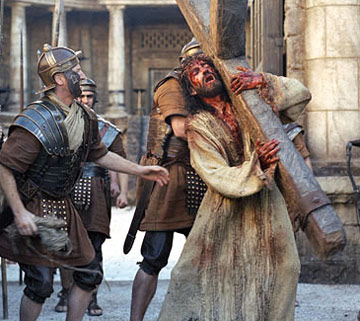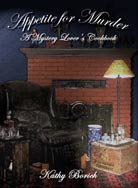The Passion of the Christ Recut: My Mother's Easter Pizza Recipe
Year Released: 2005
Directed by: Mel Gibson
Starring: James Caviezel, Maia Morgenstern, Monica Bellucci, Hristo Shopov
(R, 120 min.)

"All great truths begin as blasphemies." George Bernard Shaw
This 2005 film was a courageous departure from the cynical, anti-religious bent of current Hollywood. If you missed this epic the first time around, this may be just the right time to see it.
George Bernard Shaw once lamented that the literal emphasis on Christ’s miracles cut off potential followers who could have been won over by his beautiful philosophy of peace, love, and forgiveness. Mel Gibson’s original The Passion of the Christ perhaps errs in the same direction with its narrow artistic focus on the physical torment of the last twelve hours in the life of Jesus of Nazareth.
In the rerelease of his controversial film, The Passion of the Christ Recut, Gibson strives, in his own words, “to make the film more palatable for Aunt Martha or Uncle Harry.” Toward this aim he eliminates five or six minutes of gore and violence. Instead of dwelling on the intense flagellation of Jesus, the camera instead cuts to Mary weeping. Also eliminated is the shot of the nail going into Christ’s hand. As Beth Jones of The Roanoke Times says, these slight changes do affect the tone by shifting the focus to the effect that Jesus’ suffering had on his loved ones. But the film still preaches to the choir in the sense that the beauty of Christ’s life and works are merely a backdrop to his ultimate sacrifice. With today population as ignorant of “the greatest story ever told” as they are of history and current events, perhaps a little more good old catechism is in order.
However, even those well schooled in Catholic orthodoxy, such as Roger Ebert with his altar boy roots, admit to Gibson’s success in making viewers more introspective. He was well familiar with the fourteen Stations of the Cross, the depiction of the last twelve hours of Christ’s life, from his boyhood. He even knew the original meaning of “passion” as derived from the Latin passus meaning “ to endure or suffer.” But he, like most of us, had been used to “pious Hollywood Biblical epics of the 1950’s which looked like holy cards brought to life.” Only after seeing Gibson’s film did he really understand Christ’s intense suffering at a visceral level.
There are those who object to the graphic portrayal and even take it as an kind of personal attack, such as David Ansen of Newsweek, who felt “abused by a filmmaker intent on punishing an audience, for who knows what sins.” He seems more offended by the film’s depiction of violent events than the events themselves.
Gibson states the main message of his film is to inspire love and forgiveness, a parallel to Christ’s life purpose. And here, forgive me, I begin to see Gibson not unlike Christ in his rattling of the establishment. Apart from any religious interpretation, Christ died for the very same reason Socrates was put to death four centuries earlier. He questioned the establishment just as Jesus did. Socrates was accused of leading youth astray by questioning the religious beliefs of the Athenians. Christ rocked the boat in a similar way by questioning the corrupt ways of the Jewish High Priests, the Pharisees. To say that the film is anti-Semitic because it shows some of these priests as less than honorable in seeking the death of someone they saw as a threat is like blaming all current Catholics for the sexual abuses and their cover up by church establishment today, as Roger Ebert so aptly points out.
So Mel rebels against the inside crowd in L.A., whom he refers to as “…the blind leading the blind with a big budget.” He takes on a Hollywood where the religions honored are secular humanism and political correctness. The “blasphemy” depicted in Martin Scorsese’s The Last Temptation of Christ is now the popular pap of The Da Vinci Code, while the scriptural account of Christ’s death has become ultra controversial.
Go figure!
Apart from the controversies surrounding the film’s emphasis on graphic violence, the, in my opinion, false accusations of anti-Semitism, I would like to bring up a point that gets less attention. Gibson also broke tradition by eschewing English for ancient Aramaic and Latin. He consulted scholars to get just the right nuances in word choice and tone. One such scholar went in to great detail about the linguistic drama played out between Pilot and Christ as they engage in a bilingual duel in politically charged Latin and Aramaic. Christ departs from Aramaic to throw Pilate’s official Latin in his face as a touché for Pilate’s patronizing use of Aramaic to him.
And why has Gibson not been given more credit for the strong treatment he gives both Marys, Christ's mother and Magdalene, both of whom are central roles, even above those of Christ’s disciples?
Finally, James Caviezel is magnificent as the Christ. He suffered as much physically during the rigorous filming as he may career wise in the future by his courageous decision to cast himself in a film that departs valiantly from the cynical anti-religious bent of current Hollywood.
—Kathy Borich
Film-Loving Foodie
After viewing The Passion of the Christ, my first thought was that it would be wrong to post a recipe after such a gut-wrenching epic, almost sacrilegious to talk about food at such a time. But on second thought, since Christians end their Spartan Lenten life on Easter Sunday and celebrate the resurrection of Christ with feasting and joy just as all religions celebrate the end of suffering, miracles, and new life, I changed my mind.
And then I remembered my mother’s Easter pizza, so different from traditional pizza that all the two have in common seems their name. When Mother made it, it was so important to use the Italian parsley, not the curly-leafed variety, which she regarded as a kind of showboat herb, all looks and no delivery. Even now, when I smell its unique sweetness, I remember by mother’s hands immersed in its perfume, and I am nine years old again, seated in the warm kitchen, helping her roll out the sticky dough.
I think this may be a regional dish, as I never have found it in Italian cookbooks. (My grandparents came from a small village about fifty miles south of Rome, near the mountain town of Potenza.) The closest I have come is calzone, but that usually has tomatoes, and my mother’s Easter pizza did not.
I am giving you the recipe exactly as my mother wrote it, which in itself was unusual, as more often Italian cooks showed or simply passed down by word of mouth their wonderful dishes. And they or at least my mother couldn’t be pinned down to exact quantities or times. After all, if you couldn’t use your instincts to cook Italian, you might as well give it up!
Some say this is an acquired taste, more mellow than the spicy sauces we generally associate with Italian cooking. It actually took my husband a little while to appreciate Easter pizza, but it is now almost as much a family tradition as coloring the eggs.
Easter Pizza

- 3 lbs. Ricotta cheese
- 3 lbs. Italian sausage
- 1 large bunch Italian parsley
- 1/2 cup or more Parmesan cheese
- *Bread dough for 1 loaf (You may use frozen, if you like)
- Olive oil
- 6 eggs
*Before she worked full time, my mother would always make the dough herself, but allowed herself the dispensation of buying frozen bread dough later on. Of course this was after the death of my grandmother, who would never have permitted such a desecration.
Preheat the oven to 325 – 350 degrees
Par cook the sausage and drain; slice into small pieces. Mix ricotta and eggs until mixture is smooth. (Save one or two egg yolks for later.) Add the sausage, parsley, and Parmesan; mix.
Roll dough until it is thin, almost twice the size of a broiler pan. Lightly oil your baking dish – a broiler pan is ideal. Put dough into pan so that 1/2 of it overhangs. Scoop filling in to about one inch thickness. Bring the remaining dough over the filling and pinch edges together with fork tines. Spread egg yolk over top and prick with fork.
Bake approximately one hour or more, until crust is golden. This can be served hot or cold. (I actually like it better cold. And I always say, the test of a good pizza, any pizza, is how good it tastes cold.)
Recipe Source: Joan Marie Griffey



 Featured
Featured